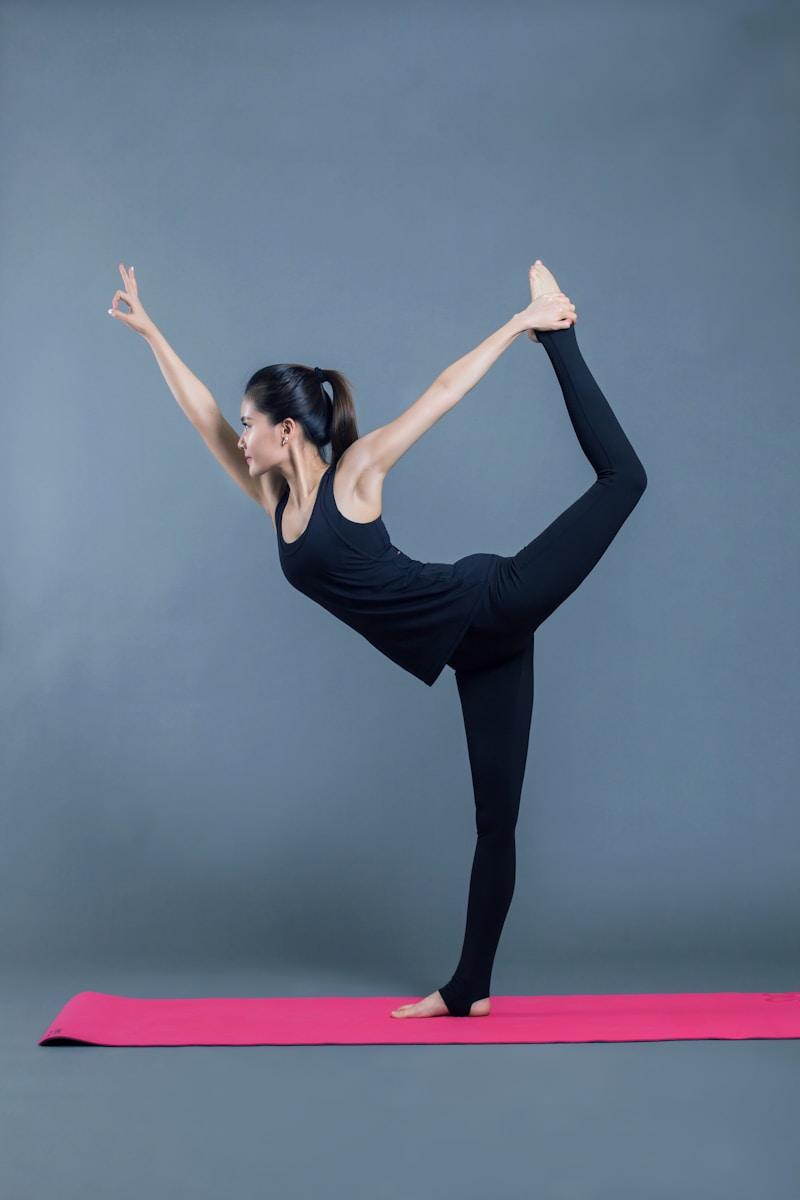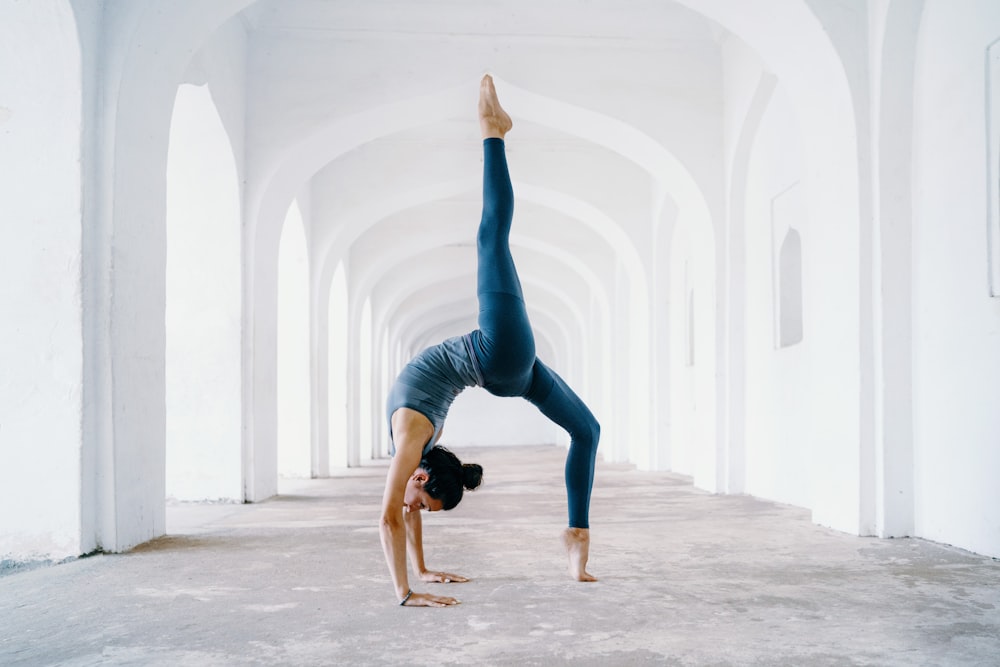

Are you feeling overwhelmed and in need of stress relief? Look no further than your yoga mat. Yoga is not just a physical practice; it is a powerful tool for calming the mind and reducing stress. By combining breathwork, meditation, and specific yoga poses, you can create a space of serenity and find relief from the pressures of everyday life.
In this article, we will explore ten yoga poses that have been proven to relieve stress and promote relaxation. These poses can be practiced individually or as part of a sequence, and they can be modified to suit your level of flexibility and comfort. So roll out your mat, take a deep breath, and let’s dive into these stress-relieving yoga poses.
1. Cat Cow Pose
Cat Cow Pose is a gentle and flowing movement that helps release tension in the spine and shoulders. By combining the arching of the back (cow pose) with the rounding of the spine (cat pose), you create a nourishing spinal massage that stimulates an emotional balance and overall feeling of calm. Focus on coordinating your breath with the movements, inhaling as you arch your back and exhaling as you round your spine.
To perform Cat Cow Pose:
- Start on your hands and knees, with your wrists directly under your shoulders and your knees directly under your hips.
- Inhale and lift your chest, arching your back and allowing your belly to sink towards the floor (cow pose).
- Exhale and round your spine, tucking your chin towards your chest and drawing your belly button towards your spine (cat pose).
- Continue flowing between these two poses, coordinating your breath with the movements, for several rounds.
2. Child’s Pose
When in doubt, take a Child’s Pose. This resting pose is a simple yet effective way to calm the mind and body, providing a sense of safety and security. Child’s Pose can be sequenced between challenging asanas or practiced on its own whenever you need a moment of relaxation.
To come into Child’s Pose:
- Kneel on your mat, with your big toes touching and your knees hip-width apart.
- Sit back on your heels and slowly lower your torso towards the floor, allowing your forehead to rest on the mat.
- Extend your arms forward or alongside your body, whichever feels more comfortable.
- Take slow, deep breaths, allowing your body to surrender to the pose and release any tension or stress.
3. Downward Facing Dog
Downward Facing Dog is a staple pose in yoga, and for good reason. It helps awaken the senses, lengthen the spine, and release tension in the entire body. As a gentle inversion, it can also help calm the mind and relieve stress. Downward Facing Dog is a great pose to practice when you feel overwhelmed or fatigued.
To practice Downward Facing Dog:
- Start on your hands and knees, with your wrists under your shoulders and your knees under your hips.
- Tuck your toes under and lift your hips up towards the ceiling, straightening your legs and forming an upside-down “V” shape with your body.
- Press your hands firmly into the mat, spreading your fingers wide for stability.
- Relax your neck and let your head hang between your arms, gazing towards your toes or belly button.
- Take slow, deep breaths, allowing your body to lengthen and release any tension.
4. Supported Headstand
Standing on your head may not seem like a stress-relieving pose at first glance, but Supported Headstand can actually calm the brain and reverse the blood flow in your body. The increased blood supply to your brain releases endorphins, which are feel-good chemicals that help reduce stress and anxiety. If you’re new to this pose or have neck issues, you can try a gentle alternative, such as a wide leg forward fold.
To practice Supported Headstand:
- Start by kneeling on your mat and interlacing your fingers, creating a cup shape with your hands.
- Place the crown of your head onto the mat, with the back of your head resting against your interlaced fingers.
- Straighten your legs and walk your feet towards your head, forming an inverted “V” shape with your body.
- Slowly lift one leg off the ground, followed by the other leg, until your body is fully inverted and your legs are pointing towards the ceiling.
- Engage your core muscles to maintain balance and stability.
- Breathe deeply and hold the pose for a few breaths, gradually increasing your time as you become more comfortable.
5. Supported Reclined Butterfly Pose
Supported Reclined Butterfly Pose, also known as Supta Baddha Konasana, is a deeply relaxing pose that opens the hips and chest while promoting a sense of surrender and calm. By placing a bolster or pillow beneath your spine and supporting your knees with yoga blocks, you can enhance the stress-relieving benefits of this pose.
To come into Supported Reclined Butterfly Pose:
- Place a bolster or pillow lengthwise on your mat.
- Sit on the bolster or pillow, allowing your spine to rest against it.
- Bring the soles of your feet together and let your knees fall open, creating a diamond shape with your legs.
- Support your knees with yoga blocks or folded blankets, if needed, to prevent any strain or discomfort.
- Place your hands on your belly and heart, close your eyes, and take slow, deep breaths.
- Allow your body to sink into the support beneath you, releasing tension and finding peace in the pose.
6. Half Pigeon Pose
Half Pigeon Pose, or Ardha Kapotasana, is a deep hip stretch that helps release tension in the hips and lower back. Sitting for extended periods can lead to tightness in these areas, contributing to stress and discomfort. By practicing Half Pigeon Pose, you can relieve tension and create a greater sense of ease and relaxation in your body.
To practice Half Pigeon Pose:
- Start in a high plank position, with your hands shoulder-width apart and your feet hip-width apart.
- Step your right foot forward, placing it just behind your right hand.
- Lower your left knee to the mat, keeping your left leg extended behind you.
- Slide your right foot towards the left side of your mat, allowing your right knee to rest on the mat.
- Flex your right foot, engaging your leg muscles for stability.
- Walk your hands forward and lower your upper body towards the mat, resting on your forearms or a block if needed.
- Breathe deeply and relax into the stretch, allowing your body to release any tension or stress.
- Repeat on the other side, stepping your left foot forward and following the same steps.
7. Bridge Pose
Bridge Pose, or Setu Bandha Sarvangasana, is a gentle backbend that calms the mind, stimulates abdominal organs, and reduces tension in the back. By expanding the front side of the body and opening the chest, Bridge Pose promotes a sense of relaxation and upliftment. You can hold the pose for a few breaths or incorporate a dynamic movement by lifting and lowering your hips.
To practice Bridge Pose:
- Lie on your back with your knees bent and your feet hip-width apart, flat on the mat.
- Place your arms alongside your body, palms facing down.
- Press your feet firmly into the mat, engaging your leg muscles.
- On an inhale, lift your hips off the mat, allowing your spine to form a gentle curve.
- Interlace your hands beneath your pelvis, pressing your arms into the mat for support.
- Relax your neck and shoulders, and gaze towards your chin.
- Breathe deeply and hold the pose for a few breaths, gradually increasing your time as you become more comfortable.
8. Forward Fold
Forward folds are an excellent way to release tension in the neck, shoulders, spine, and hamstrings. The simple act of allowing your upper body to hang heavy promotes a sense of surrender and relaxation. By adding gentle movements and variations to your forward fold, you can enhance the stress-relieving benefits of this pose.
To practice Forward Fold:
- Stand tall with your feet hip-width apart and your arms alongside your body.
- On an exhale, slowly hinge forward at your hips, allowing your upper body to fold over your legs.
- Bend your knees slightly to relieve any strain in your hamstrings and lengthen your low back.
- Let your head hang heavy and relax your neck and shoulders.
- Shake your head yes and no a few times to release tension in your neck.
- For a deeper stretch, interlace your hands behind your back and allow your arms to hang overhead.
- Breathe deeply and hold the pose for a few breaths, allowing your body to release any stress or tension.
9. Eagle Pose
Eagle Pose, or Garudasana, is a balancing pose that improves concentration, balance, and flexibility. By squeezing and releasing different parts of your body, you can stimulate the major joints and release tension. Eagle Pose empowers you to let go of stress and embrace a sense of strength and stability.
To practice Eagle Pose:
- Start in a standing position with your feet hip-width apart and your arms alongside your body.
- Bend your knees slightly and lift your right leg, crossing it over your left leg.
- Hook your right foot behind your left calf, if possible.
- Extend your arms forward and cross your right arm over your left arm, bringing your palms to touch or hugging your shoulders.
- Engage your core muscles and find a focal point to help with balance.
- Breathe deeply and hold the pose for a few breaths, gradually increasing your time as you become more comfortable.
- Repeat on the other side, crossing your left leg over your right leg and left arm over your right arm.
10. Legs Up the Wall
Legs Up the Wall, or Viparita Karani, is a restorative pose that promotes relaxation and activates the parasympathetic nervous system. By placing your legs up the wall, you allow your body to shift from the fight-or-flight response to the rest-and-digest state. This pose is accessible to everyone and can be practiced anytime, anywhere.
To practice Legs Up the Wall:
- Sit on the floor with your right side against a wall.
- Lie down on your right side and swing your legs up the wall, keeping your torso on the mat.
- Adjust your position so that your sitting bones are as close to the wall as comfortable for you.
- Extend your arms alongside your body, palms facing up.
- Close your eyes and take slow, deep breaths, allowing your body to relax and release any stress or tension.
- Stay in the pose for a few minutes or longer, depending on your comfort level.

